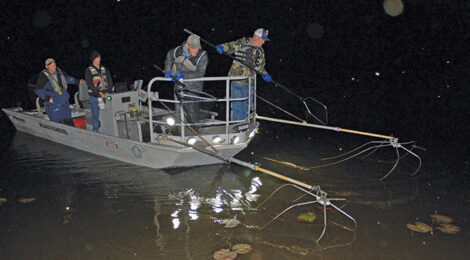
Numbers Game
A look at electrofishing and other survey techniques biologists use for assessing fish populations.
Story by Matt Williams
LAKE NACOGDOCHES — It’s just after sunset on a pleasant spring evening and all is quiet at the upper reaches of Lake Nacogdoches in eastern Texas.
Things are about to change, though. Todd Driscoll and his crew just rolled up in their 20 foot electrofishing rig.
The upcoming drill is representative of every springtime electrofishing survey — crank up the juice, rattle some cages and gather some useful trend data on bass populations.
Welcome to the world of a Texas Parks and Wildlife Department freshwater fisheries biologist. Driscoll is one of 14 district supervisors with the state agency’s inland fisheries division.
Like other leaders, the scientist is tasked with managing Texas’ freshwater fisheries for the best fishing possible while protecting and enhancing our aquatic resources. Driscoll has nine public reservoirs totaling more than 300,000 surface acres under his watch — a small fraction of what is out there.
Conducting periodic surveys play a vital role in helping biologists gather information used in making fisheries management decisions. The surveys range in scope from simply talking to anglers to using nets, traps and shocking devices for sampling sport fish populations.
Here’s a synopsis of primary sampling methods and surveys TPWD biologists use to keep check on our freshwater fisheries and assess how well the angling public is satisfied with them:
Electrofishing
************************************************************************
To read more, click here to SUBSCRIBE








